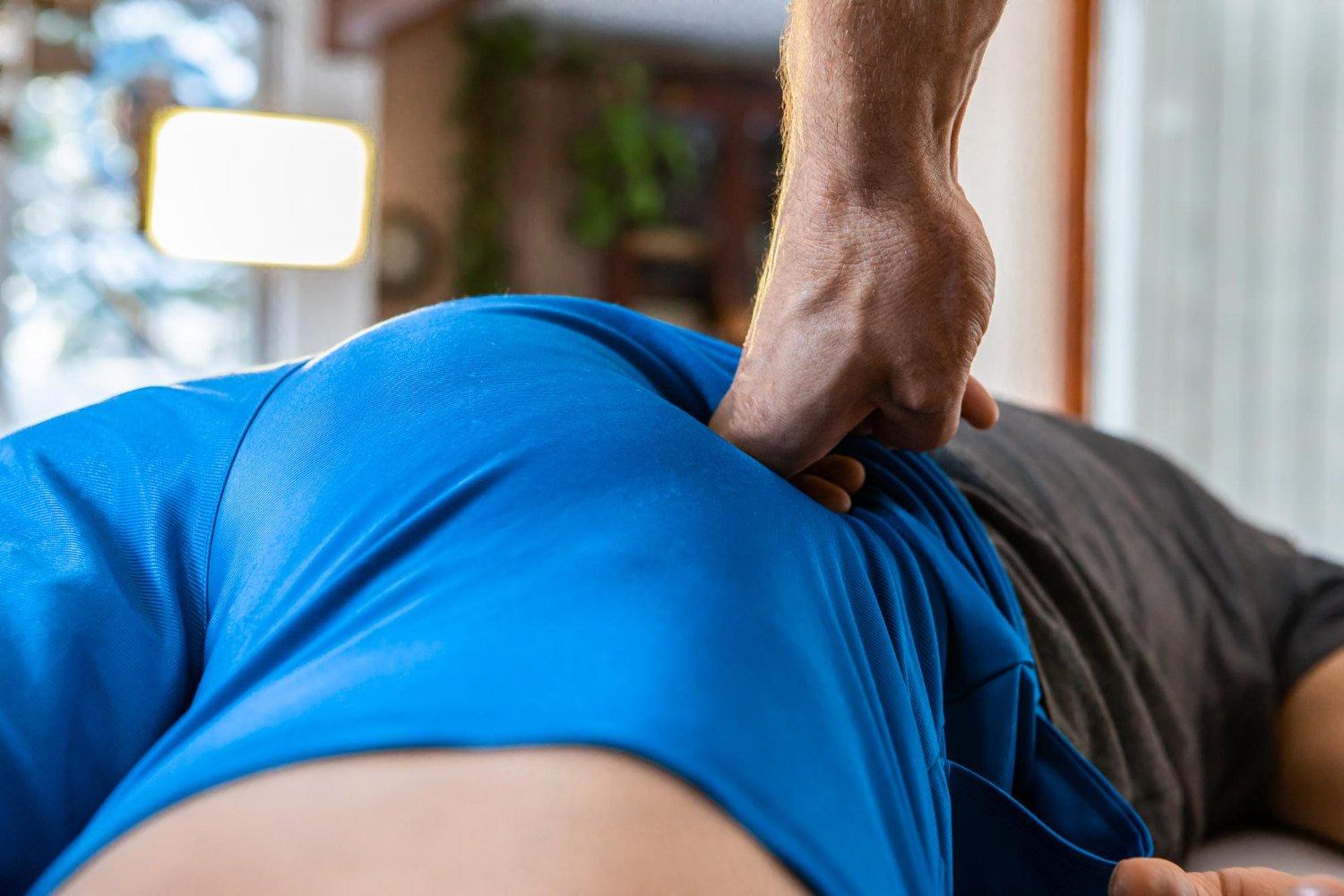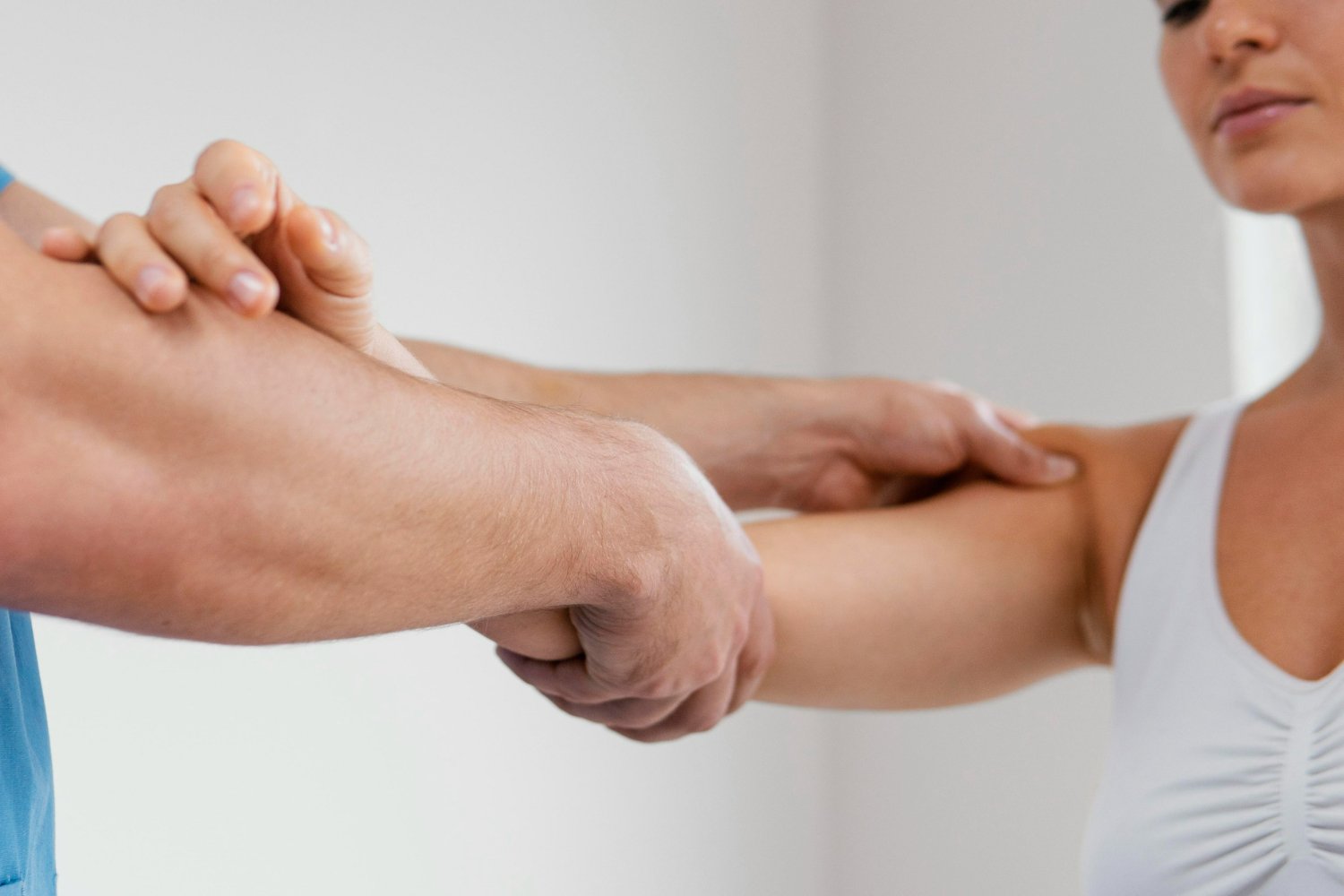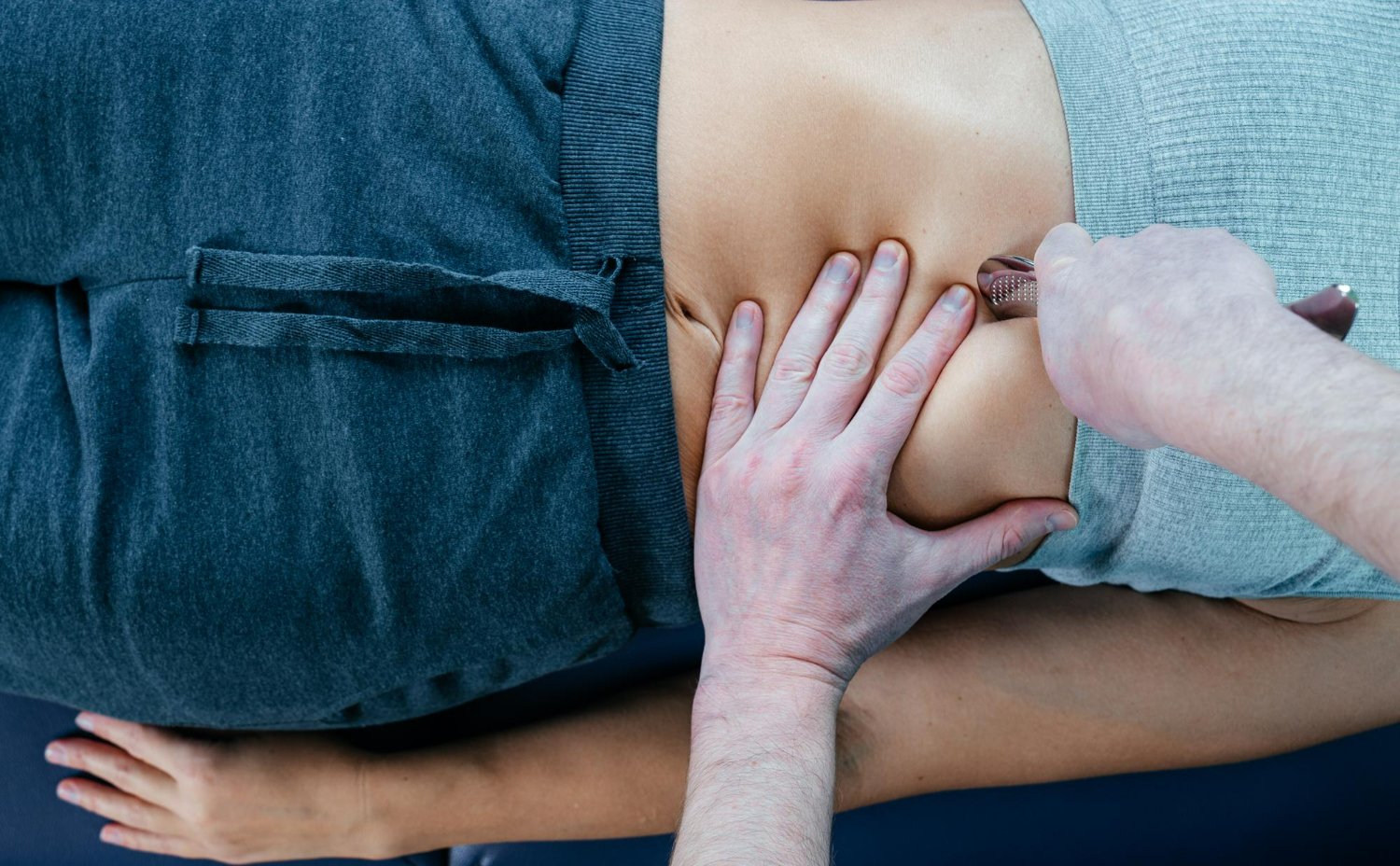Muscle knots, or myofascial trigger points, are familiar yet painful phenomena that affect countless individuals, especially those engaged in active or physically demanding lifestyles. These knots are areas of tension within the muscle fibers that form when muscles fail to relax. Muscle knots can lead to significant discomfort and reduced mobility, often palpable as nodules or tight bands under the skin.
In the dynamic and active community of DFW, Texas, the prevalence of muscle knots is notably high. This is likely due to the combination of a highly active lifestyle and the stresses of daily commutes and desk-bound jobs that characterize the area. Understanding what muscle knots are, how to identify them, and how to effectively treat them through chiropractic muscle relief can significantly enhance one’s quality of life by alleviating pain and improving physical function.

Identifying Muscle Knots
Recognizing Symptoms of Muscle Knots
Muscle knots can manifest through various symptoms, the most common being persistent or sporadic pain in a concentrated area. This pain might intensify with physical activity or stress and often feels like a deep ache that is difficult to soothe.
The affected muscle may feel swollen or tense to the touch, and in some cases, these knots can also cause referred pain, misleadingly affecting different parts of the body.
Identifying muscle knots often involves palpating the affected area to feel for tense muscle fibers or bands that are tender to touch. These knots can cause a significant decrease in movement range, leading to stiffness and discomfort during normal daily activities.
Common Areas for Muscle Knots
Muscle knots can develop in any body part where muscle tissue is present but are most commonly found in the neck, shoulders, lower back, and legs. These areas bear the brunt of everyday stress and strain:
- Neck: Frequently strained by poor posture during phone and computer use.
- Shoulders: Often overworked from lifting, carrying, or repetitive motion.
- Lower Back: Typically affected in individuals who sit for prolonged periods or frequently bend and lift heavy objects.
- Legs: Common in runners and athletes who engage in repetitive motion sports.
Muscle Knot Treatment through Chiropractic Care

Chiropractic care provides a holistic approach to treating muscle knots by focusing on the symptomatic area and addressing the underlying causes of muscle tension. Chiropractic muscle relief involves various techniques tailored to the individual’s specific needs.
Chiropractic Adjustments
Chiropractic adjustments can realign the spine and other joints, reducing pressure on the nervous system and improving blood flow to the tense muscles. This enhanced circulation helps flush out toxins and nourishes the muscles, promoting faster healing.
Manual Therapy Techniques
Chiropractor muscle therapy often includes manual techniques such as massage or myofascial release, which directly target and break down the muscle knots. These techniques help to release the tension in the trigger points, providing immediate muscle tension relief.
Tailored Exercise Programs
In addition to direct treatments, chiropractors often prescribe specific exercises to stretch and strengthen the muscles surrounding the muscle knot. These exercises help prevent the recurrence of knots by improving muscle balance and posture.
Integration with Other Therapies
In some cases, chiropractic care DFW may be combined with other treatments such as heat therapy, ultrasound, or electrical stimulation to enhance the healing process and provide comprehensive muscle pain treatment.
Understanding and treating muscle knots through chiropractic care can significantly improve pain, mobility, and overall quality of life. If you are dealing with persistent muscle pain or knots, consider consulting with a muscle knot chiropractor to explore your options for relief and recovery.
Diagnostic Approaches in Chiropractic Care
Effective management of muscle knots involves precise diagnostic techniques that enable chiropractors to accurately identify and treat these painful areas. Chiropractic care, renowned for its holistic approach to musculoskeletal issues, employs physical examination techniques and a thorough review of patient history to diagnose and treat muscle knots effectively.
Physical Examination Techniques
The first step in addressing muscle knots through chiropractic muscle relief is a detailed physical examination. Chiropractors are trained to use their hands as finely tuned instruments to detect abnormalities and tensions in the muscle tissue. Here’s how they do it:
- Palpation is the most common technique for identifying muscle knots. Chiropractors palpate or feel the muscles with their hands, searching for abnormally firm areas or those that twitch when touched. These are indicative of muscle knots.
- Range of Motion Tests: Chiropractors assess the range of motion in various joints. Restrictions in movement can often lead to muscle imbalances that contribute to the formation of knots.
Posture Analysis: Observing the patient’s posture can provide clues about muscle imbalances and areas of chronic tension that might contribute to muscle knots.
Through these hands-on techniques, chiropractors can locate the precise areas where muscle knots are causing pain and mobility issues, making it possible to tailor muscle knot treatment effectively.
The Role of Patient History in Diagnosing Muscle Knots
Understanding a patient’s medical and lifestyle history is crucial in the chiropractic approach to treating muscle knots. This comprehensive background check includes:
- Activity Level and Occupational Hazards: Knowing the types of activities a patient regularly engages in helps chiropractors understand potential sources of muscle strain. For instance, repetitive motions or prolonged sitting can often lead to muscle knots.
- Previous Injuries: A history of muscle injuries can make certain areas more susceptible to developing muscle knots. Chiropractors use this information to focus their treatment on these vulnerable areas.
- Lifestyle Factors: Diet, stress levels, and exercise routines are considered, as they influence muscle health and the tendency to develop muscle knots.
This thorough understanding helps chiropractors treat existing muscle knots and advise patients on changes to their lifestyle or activities that might prevent future occurrences.
Implementing Chiropractic Muscle Relief
Once the muscle knots are identified, chiropractors use various techniques to provide relief. These may include direct pressure, massage techniques specifically aimed at breaking down the knots, and adjustments that help realign the body’s structure and relieve muscle tension. Additionally, chiropractic care DFW often incorporates advice on exercises and stretches that patients can do at home to prevent the reformation of muscle knots.
Chiropractic methods offer a non-invasive, effective way to fix muscle knots and restore full function. By combining a deep understanding of anatomy with comprehensive patient insights, chiropractors provide personalized muscle pain treatment plans that address the symptoms and the root causes of discomfort, leading to longer-lasting muscle tension relief. If you struggle with persistent muscle pain, consider consulting a muscle knot chiropractor who can offer targeted treatment and guidance.

Integrative Approaches to Muscle Knot Relief
Addressing muscle knots effectively often requires a comprehensive approach that combines multiple therapeutic modalities. Chiropractic care, known for its ability to provide muscle tension relief and muscle pain treatment, can be significantly enhanced when integrated with other therapies. This synergistic approach not only helps to fix muscle knots but also optimizes overall musculoskeletal health.
Combining Chiropractic Care with Other Therapies
Integrating additional therapeutic techniques with chiropractic adjustments can provide a more holistic treatment plan for those suffering from muscle knots. These therapies include:
- Ultrasound Therapy: Ultrasound uses sound waves to deliver deep heat to soft tissues and joints. This therapy can help increase blood flow, reduce swelling, relieve pain, and enhance healing, making it a valuable adjunct to chiropractic muscle relief.
- Heat Therapy: Applying heat can help relax and loosen tissues and stimulate blood flow to the area of a muscle knot. When used with chiropractic adjustments, heat therapy can help soften the muscle knots before manual manipulation, allowing for more effective treatment.
- Electrical Stimulation: This method uses electrical currents to cause a single muscle or a group of muscles to contract. Electrical stimulation can aid the muscle knot treatment process by helping to manage pain and increase strength and muscle stability by preparing the muscles for more active rehabilitation.
Chiropractors often employ these therapies to enhance manual adjustments’ healing effects and provide pain relief and functional improvement more quickly than standalone treatments.
Holistic Lifestyle Changes
In addition to treatments, making specific lifestyle changes can significantly impact the prevention and management of muscle knots. Recommendations often include:
- Ergonomic Adjustments: For those spending long hours at a desk or involved in repetitive motions, making ergonomic improvements can help reduce strain and prevent the formation of muscle knots. Suggestions might include optimizing the setup of a workstation, using ergonomic chairs, or taking regular breaks to stretch and move.
- Dietary Tips: Nutrition plays a critical role in muscle health and recovery. Increasing anti-inflammatory foods such as omega-3 fatty acids, turmeric, and ginger can help reduce muscle inflammation and aid healing. Hydration is also crucial as water helps to keep the muscles supple.
- Regular Physical Activity: Incorporating regular exercise into one’s routine can help maintain muscle tone and prevent the stiffness associated with muscle knots. Activities like yoga and Pilates are particularly beneficial as they focus on core strength, flexibility, and proper postural alignment.
- Stress Management: Since stress can contribute to muscle tension and the development of muscle knots, employing stress-reduction techniques such as meditation, deep breathing exercises, or regular physical activity can be beneficial.

Preventive Strategies and Patient Education
Effectively managing muscle knots involves treating existing conditions and implementing strategies to prevent their recurrence. Education on proper physical health practices and the benefits of routine chiropractic care is crucial for long-term muscle health and overall well-being.
Education on Preventing Muscle Knots
Understanding the causes and prevention of muscle knots can dramatically reduce their frequency and severity. Here are some educational tips that everyone should know:
- Proper Exercise Techniques: Incorrect exercise techniques can easily lead to muscle strain and the development of muscle knots. Educating individuals on the correct ways to perform exercises, particularly those that involve heavy lifting or repetitive motions, is crucial.
- Posture Awareness: Poor posture significantly contributes to muscle knots, especially in the neck and back. Regular workshops on posture correction can teach individuals how to adjust their sitting, standing, and walking postures to minimize muscle stress.
- Stress Reduction: Since stress can tighten muscles and contribute to the formation of knots, stress management techniques such as deep breathing exercises, yoga, and mindfulness meditation are often recommended. These practices not only help relieve muscle tension but also enhance overall mental and physical health.
Routine Chiropractic Care as a Preventive Measure
Routine chiropractic visits play a pivotal role in maintaining musculoskeletal health and preventing the occurrence of muscle knots. Regular adjustments ensure the body maintains proper alignment, preventing muscle imbalances that often lead to knots. Here’s how ongoing chiropractic care helps:
- Regular Muscle Assessments: Frequent evaluations by a muscle knot chiropractor can help catch tension and imbalances early before they develop into painful knots.
Alignment Corrections: Misalignments in the spine and joints can contribute to abnormal muscle tension. Chiropractic adjustments correct these misalignments, thereby reducing muscle strain and preventing muscle knots. - Enhanced Flexibility and Mobility: Chiropractors often incorporate stretching and strengthening exercises into their treatment plans, which can improve flexibility and mobility. This not only aids in the recovery from existing muscle knots but also prevents new ones from forming.
- Personalized Advice: Based on individual assessments, chiropractors can provide personalized advice on lifestyle changes, exercise routines, and ergonomic setups that specifically aim to prevent muscle issues.
The key to effectively dealing with muscle knots is treatment and prevention. By educating individuals on how to care for their muscles through proper exercise, posture, and stress management and emphasizing the importance of routine chiropractic care, it is possible to reduce the occurrence of these painful conditions significantly.
Regular chiropractic visits address existing musculoskeletal issues and serve as a preventive measure to maintain overall health and prevent future discomfort. If you struggle with muscle knots, consider incorporating these preventive strategies into your lifestyle and experience the benefits of a holistic approach to muscle health.

The Value of Chiropractic Care in Muscle Knot Management
The discomfort and impairment caused by muscle knots can significantly impact daily life, but chiropractic care provides a powerful solution. This approach helps fix muscle knots and addresses the root causes to prevent their recurrence. Here’s why individuals suffering from muscle discomfort should consider chiropractic solutions:
- Muscle Knot Treatment: Chiropractic care effectively identifies and treats muscle knots. Techniques like direct pressure, massage, and manual manipulation work directly on the affected areas, releasing tension and providing immediate muscle pain treatment.
- Chiropractic Muscle Relief: Beyond simple pain relief, chiropractic adjustments enhance overall musculoskeletal health by improving spinal alignment and reducing nerve interference. This holistic approach helps the body heal and maintain its natural balance.
- Preventive Care: Regular chiropractic visits proactively manage bodily stresses that often lead to muscle knots. Chiropractors provide valuable guidance on posture, ergonomics, and lifestyle habits contributing to muscle health, ensuring that patients recover and thrive.
Chiropractic care offers a non-invasive, drug-free option that effectively manages and prevents the formation of muscle knots, promoting better health and enhanced quality of life. If you are struggling with persistent muscle tension relief issues, consider exploring the benefits of chiropractic treatments.





